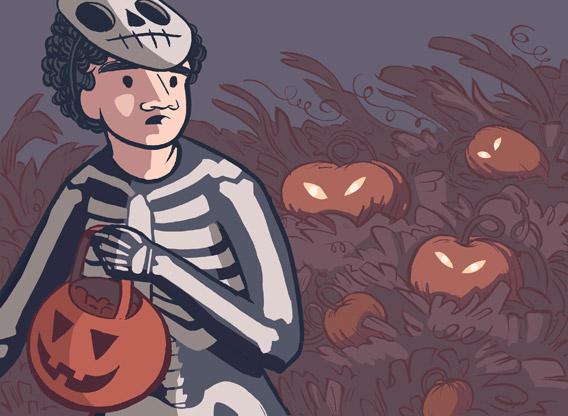Here’s how Devin O’Bannon, one of the protagonists in the newest Goosebumps novel, knows the pumpkin farm he’s staying at is haunted. After a night of bad dreams, he wakes, stretches, and lowers his feet to the floor. “I expected to feel the hard floorboards,” he tells us. “But instead, my bare feet sank into something warm and squishy,” a “round puddle” of “drippy orange-yellow goo.” Pumpkin guts! A loony rewrite of Kafka! Classic Goosebumps: funny, icky, and just a bit menacing.
R.L. Stine’s fiendishly popular children’s series arrived in 1992, with Welcome to Dead House. By 1997, Stine had produced 93 of the kiddie horror books, to be followed by scores more in relaunches like Goosebumps 2000, Goosebumps HorrorLand, and Goosebumps Most Wanted.
The novels are still around, delivering mild chills to anyone who hasn’t been lured away by boy wizards and dreamy Byronic vampires. They have names like The Werewolf of Fever Swamp and Piano Lessons Can Be Murder. (Stine told me in an interview that he always begins with the title. His favorite to date is Little Shop of Hamsters.) Once, they propagated through bookstores like an alien mold; now, the series is more like a dormant monster, sleeping quietly, biding its time. The books are still paragons of children’s horror, ghoulish cartoons aimed at the sweet spot between alarm and delight.
All horror is for kids. Adult horror is for kids in adult bodies and children’s horror is for kids in kids’ bodies. The more meaningful difference between the two genres lies in what they do with the boogeymen they conjure up. Frightfests for children tame and temper our fears, while adult horror breaks through our mature defenses to inform us that the monster under the bed is real.
In Goosebumps books, the monster’s powers were so diminished by goofiness and snark that at times it seemed his true role was to initiate you into the lifelong practice of stress management. Skeletons kept losing appendages. Ghosts popped out of the closet with the predictability of a Jack-in-the-box. The strange, subtle thing about being a kid, though, was that you never quite trusted Stine’s reassurances. You feared that the playfulness, the safety nets, might vanish in an instant, leaving you alone in the dark. They never did, of course, but the possibility glowed over every page like a will-o-the-wisp. Enter adult horror, which deals in the primal terrors that surge most strongly in children—and yet does nothing to soften or gentle them.
This not-so-sweet spot is where Stine should be aiming with his new novel for grown-ups, Red Rain. But somewhere in his bid to seduce Goosebumps fans now in their 20s and 30s, he stumbles. The book yearns to be scary—not Goosebumps kinda-scary or wacky-scary but truly bloodcurdling—and it almost succeeds. At least, all the markers of terror are there: gore and a high body count and characters who try to scream but no sound came out. Yet something about Red Rain, a tale of eerily beautiful twin boys who shoot laser beams out of their eyes, fails to connect. It contains viscera, but is not visceral. Not only is Stine not writing for children, he has stopped writing for readers’ susceptible inner child.
That’s a bad idea when your book has a premise that would appear ludicrous to most adults. (To be fair, few supernatural fantasies seem plausible to anyone over the age of 12.) It’s a worse one when the desire for maturity makes your prose grim and cheerless. Red Rain suffers from an overly grown-up sensibility: It feels too controlled, too fussy, too bogged down in detail. The dominant tone is elegiac rather than exciting: Passages linger over the aftermath of destruction—a house’s splintered remains, a charred body—rather than the unwinding blow of it. One character even sleeps through a hurricane, waking just in time to survey the wreckage. When she goes outside, she hears “the pleas of the injured waiting to be rescued … survivors discovering their dead … sweating, cursing men digging, pawing, shoveling into the rubbled houses.”
The slog, the numbness, the taking stock of damage, the cleaning up. What anchors Red Rain in adult reality also defangs it. I would so love to see Stine abandon his newfound commitment to realism and coherence. If only he’d plunge us back into the chaos of childhood—but this time without the failsafes of his trademark goofiness.
True, Stine’s descriptions of the haunted isle have a lush eeriness. A ritual that purports to raise the dead is odd and hallucinatory, and the hurricane hits with more-than-natural fury. The biblical names of the twins, Samuel and Daniel, ladle on the cosmic resonance, as does a plague-like blood rain that sweeps down over the first scene like a curtain. (“Showtime,” I can imagine Stine whispering.) But this dense, mythy atmosphere evaporates when the action moves to Long Island. A few lurid passages might feel more at home on the Bulwer-Lytton Fiction Contest website. (“She made a hoarse choking sound, grabbing frantically at the waterfall of shiny wet organs spilling out. Spilling out of the deep slit across her belly. A gusher of pink and yellow sausage oozing through her fingers.”) And I was disappointed that no one, least of all the author, seemed interested in the most menacing thing about twins: their uncanny doubleness.

Author R.L. Stine.
Courtesy of the author.
By contrast, the newest Goosebumps book, Wanted: The Haunted Mask, is a joy. Spunky Lu-Ann Franklin puts on an enchanted mask and goes on a rampage. Meanwhile, her best friend Devin is spending Halloween at a pumpkin patch his father recently bought to make some extra money. The gourds seem possessed of a strange animation; vines twist like serpents and scratch at the windows. It turns out that the earth beneath the fields houses the bodies of hundreds of Civil War dead, who send their wrath up through the creepers and into the squash.
Angry pumpkins: perhaps, not so scary. And yet Stine makes it work. His vision of the fields by moonlight, of pumpkin leaves that “slap against one another” with a sound “like hands clapping,” collapses two meanings of funny: funny-peculiar and funny-ha-ha. Which is exactly how Horror for Kids should operate, provoking and assuaging fear all at the same time.
I say provoking because, no matter how whimsically or sarcastically Stine handles them, the themes in Goosebumps pulse with native power. Inanimate objects turning malicious are creepy. False faces are creepy. They threaten the integrity of the self, and sometimes, as with Lu-Ann, they blur the line between monster and victim. When I read the first Haunted Mask in the 1990s (the motif figures in at least three Goosebumps books), the idea that I might originate the forces most deadly to me held an aching suggestiveness. It was not an epiphany that seemed immediately relevant, so I stored it away. And then adulthood hit, and I was just a little more prepared than I might otherwise have been.
Relentlessly plot-driven, with fun, smart-alecky narrators my age or a little older, the Goosebumps novels were slightly transgressive (my parents hated them), as well as a hobby to share with friends. (Those covers, queasily luminous, with the letters bulging like an inflammation, made great collectibles.) A new one rolled out every month or so and I’d gobble it up in a sitting, sometimes flipping to the last page first to make sure of the twist ending. Only now do I realize what I was really scanning for: my fears, mostly stabilized and tamed. But not quite defeated.
—
Red Rain by R.L. Stine. Touchstone.
Goosebumps Wanted: The Haunted Mask by R.L. Stine. Scholastic.
See all the pieces in this month’s Slate Book Review.
Sign up for the Slate Book Review monthly newsletter.
